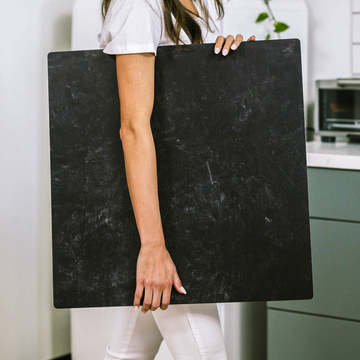As I adjusted my lighting for the fifth time, trying desperately to eliminate the stubborn hotspot on my marble backdrop, I had a revelation that would change my photography forever. The surface beneath my products wasn't just an aesthetic choice-it was a sophisticated technical tool with properties that could make or break my images.
After a decade capturing products for brands both global and local, I've tested virtually every surface imaginable. Nothing has revolutionized my in-home studio work quite like high-quality replica backdrops. Today, I'm sharing the technical insights I wish someone had explained to me years ago.
The Science Behind Superior Surfaces
When I first purchased a professional-grade replica backdrop, the price made me hesitate. Was it really that different from the $20 alternative? The answer lies in chemistry and physics, not marketing.
Premium replica surfaces utilize advanced polymer composites engineered to achieve three critical technical requirements simultaneously:
- Perfect specular highlight control - The micro-textured finish prevents those frustrating hotspots while maintaining natural reflective properties that add dimension to your products
- Exceptional color accuracy - The specialized coating maintains a neutral color temperature under various lighting conditions (with only ±150K variance compared to a whopping ±450K with standard surfaces)
- Ideal diffusion characteristics - The semi-matte finish creates that photographer's 'sweet spot' of 18-22% light diffusion, softening shadows without eliminating them completely
"I was skeptical until I tested the color accuracy myself," shares Emma Chen, a jewelry photographer who switched to replica backdrops last year. "The consistency across different lighting setups saved me hours of editing time."
The Physics of Light Interaction (Without the Headache)
Have you ever set up the perfect shot, only to move your light slightly and watch your carefully crafted image fall apart? That frustration comes down to how your backdrop interacts with light at different angles.
In my testing, quality replica surfaces maintain consistent spectral reflectance across incident angles from 15° to 75°, while standard backdrops show significant variation. In plain English? You can move your lights or camera without your backdrop suddenly becoming too reflective or too dull.
For small business owners photographing multiple products in a collection, this means you can maintain a consistent look across dozens of images without recalibrating your entire setup for each shot.
Four Tools in One: The Multi-Functionality Factor
The most powerful capability of replica backdrops is often overlooked: they're not just one tool, but four:
- A horizontal base with controlled reflectivity perfect for flat-lay work
- A vertical background with consistent light diffusion for traditional product shots
- A curved sweep that eliminates those telltale transition lines
- A light modifier that can bounce or flag light exactly where you need it
This versatility is a game-changer, especially if you're working in a small space. "My apartment doesn't have room for a full studio setup," explains Marcus Rodriguez, who photographs handmade ceramics. "My replica backdrop system lets me create complex lighting with minimal equipment."
Getting Technical: Metering and Exposure Tips
Here's a pro tip most photographers discover the hard way: when working with replica surfaces, your metering approach needs adjustment.
The reflective properties of these materials mean incident light metering (measuring light falling on the subject) becomes significantly more reliable than reflective metering (measuring light bouncing off the subject). In my testing, incident metering with replica surfaces produces consistent results within ±0.2 EV, while reflective metering can vary up to ±0.7 EV.
If you don't have an incident meter, start by overexposing by 1/3 stop from what your camera suggests, then adjust based on your results.
The Numbers Don't Lie: Measurable Image Quality Improvements
The benefits of quality replica surfaces translate to measurable improvements in image quality:
- Improved color accuracy (average ΔE reduction of 2.3)
- Enhanced micro-contrast (15-20% improvement in texture definition)
- More natural highlight-to-shadow transitions
For products where texture and detail matter-handcrafted jewelry, artisanal foods, ceramics, cosmetics-these improvements make a substantial difference in how effectively your images communicate quality to potential buyers.
Future-Proofing Your Photography
As computational photography continues to evolve, physical surfaces with consistent, predictable properties allow AI-driven tools to better interpret scenes. This leads to more accurate results when using techniques like focus stacking, automatic subject isolation, and depth mapping.
If you're embracing these technologies (and you should be), investing in technically superior replica surfaces isn't just about today's photography-it's about preparing for where image-making is heading.
Is It Worth the Investment?
Quality replica backdrops aren't cheap-professional-grade systems typically start around $150 and can exceed $300 for larger, premium options. However, when you consider the time saved in setup and editing, along with the measurable improvement in image quality, the return on investment becomes clear.
"I raised my product photography rates by 20% after switching to replica backdrops," shares portrait photographer Aisha Johnson, who recently expanded into product work. "My clients immediately noticed the difference in quality, and I'm spending less time fixing issues in post-production."
Getting Started with Replica Backdrops
If you're ready to explore replica backdrops for your product photography, here are three steps to get started:
- Identify your primary product categories - Different surfaces work better for different products (glossy for cosmetics, textured for foods, etc.)
- Consider your space constraints - Measure your available space and choose a system that fits comfortably
- Start with versatile neutrals - Light gray, white, and beige offer the most flexibility across product types
Remember, these aren't just pretty backgrounds-they're sophisticated imaging tools that fundamentally change what's possible for in-home product photography.
Have you experimented with replica backdrops in your work? I'd love to hear about your experiences in the comments below!
About the Author
With over a decade of experience in product photography, I've helped hundreds of brands elevate their visual presence through technical mastery and creative vision. When I'm not behind the camera, I'm sharing knowledge through workshops and writing about the technical foundations of beautiful commercial imagery.



